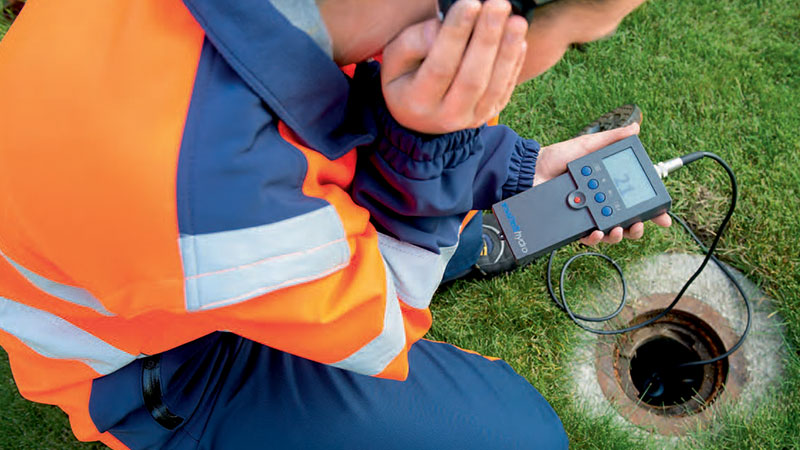Cutting-edge Solutions for Early Discovery of Water Leaks in Structures and Facilities
From innovative leakage discovery innovations to the deployment of IoT sensors for real-time monitoring, the landscape of leakage prevention is progressing swiftly. Automated water circulation evaluation systems are improving just how leakages are determined and attended to, leading the method for a positive technique to water leakage detection.
Advanced Leak Detection Technologies
Advanced leak discovery modern technologies, outfitted with sophisticated sensing units and algorithms, play a vital duty in quickly recognizing and pinpointing water leaks in various settings. Electromagnetic sensing units can recognize adjustments in electro-magnetic areas triggered by water, providing yet an additional layer of leak discovery ability.

IoT Sensors for Real-Time Surveillance
In the world of contemporary water leakage discovery, the combination of IoT sensing units for real-time surveillance stands for a critical improvement in boosting positive leakage detection capabilities. These sensors provide constant surveillance of water supply, giving real-time data on water flow rates, pressure variations, and temperature changes. By leveraging IoT innovation, these sensing units can detect even the smallest abnormalities in water use patterns, making it possible for very early recognition of prospective leakages prior to they rise into major issues.
IoT sensors transfer information to a central platform, where sophisticated formulas examine the info and create signals or alerts when abnormalities are detected. This real-time monitoring capability allows homeowner or center supervisors to immediately attend to leakages, lessening water damage, decreasing repair work costs, and conserving water sources.
In addition, IoT sensing units can be incorporated with structure administration systems, permitting automated feedbacks to identified leakages, such as shutting down water shutoffs or activating pumps to reduce the impact of leakages. On the whole, the execution of IoT sensing units for real-time surveillance substantially improves the efficiency and effectiveness of water leakage discovery in structures and facilities.
Artificial Intelligence Algorithms for Leakage Forecast

One trick benefit of making use of artificial intelligence for leakage prediction is its ability to constantly find out and enhance its accuracy over time. As even more information is collected and fed into the formula, it can fine-tune its predictions and adjust to altering problems, eventually raising the dependability of leak discovery systems.
Furthermore, artificial intelligence formulas can help in recognizing subtle indicators of leaks that might go unnoticed by typical tracking approaches. water leak detection. By examining intricate data collections click to investigate in real-time, these algorithms can supply early cautions and alerts, permitting for timely intervention and precautionary maintenance to minimize prospective water damage and connected costs
Utilizing Thermal Imaging for Leakage Detection
Thermal imaging technology uses a promising strategy for finding water leaks in different systems and infrastructures. By making use of infrared radiation and temperature variations, thermal imaging electronic cameras can identify concealed leaks that are not quickly noticeable to the nude eye. When water leaves from pipelines or structures, it typically changes the temperature of the bordering location, developing temperature differentials that thermal cameras can catch. These temperature level irregularities are after that translated into noticeable images, highlighting the precise area of the leak.
Among the vital benefits of thermal imaging for leak detection is its non-intrusive nature. Unlike standard approaches that might call for burglarizing wall surfaces or floorings to situate leakages, thermal imaging enables non-destructive testing. This not only conserves time and click for info reduces costs however likewise decreases disruption to the building or facilities being evaluated. Furthermore, thermal imaging can swiftly check large areas, offering an extensive summary of possible leak resources in a timely way. Generally, using thermal imaging modern technology boosts the efficiency and accuracy of water leakage detection, making it a useful device for keeping the honesty of structures and frameworks.
Automated Water Circulation Analysis Equipments
Exactly how can automated water circulation evaluation systems reinvent the detection and monitoring of leaks in different systems and infrastructures? Automated water circulation analysis systems supply a positive technique to leak detection by continually checking water flow prices and patterns. By establishing standard data, these systems can rapidly recognize discrepancies that might indicate a leak, making it possible for prompt intervention to protect against substantial damages.
These systems utilize sophisticated formulas to analyze real-time data and give immediate informs when abnormalities are spotted, permitting speedy action to be taken. Additionally, automatic water circulation evaluation systems can be integrated with building administration systems or IoT systems, boosting overall efficiency and allowing remote surveillance capabilities.
In addition, the information accumulated by these systems can be used for predictive maintenance purposes, helping to identify potential weak points in the infrastructure prior to leakages take place. On the whole, the implementation of automated water flow analysis systems can significantly improve leakage discovery and monitoring methods, eventually resulting in cost financial savings, minimized water waste, and enhanced over at this website sustainability in buildings and framework.

Verdict
In conclusion, the integration of advanced leak detection technologies, IoT sensors, artificial intelligence formulas, thermal imaging, and automatic water flow analysis systems provides ingenious services for early detection of water leaks in buildings and infrastructure. These technologies enable real-time monitoring, prediction of leakages, and reliable discovery methods to avoid water damages and wastage. Applying these options can help in preserving the stability and sustainability of water supply in different setups.